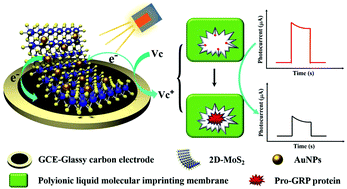A pro-gastrin-releasing peptide imprinted photoelectrochemical sensor based on the in situ growth of gold nanoparticles on a MoS2 nanosheet surface†
Abstract
Lamellar MoS2 nanosheets were successfully prepared by hydrothermal synthesis using 1-(3-mercaptopropyl)-3-methyl-imidazolium bromine (MIMBr) ionic liquid as a sulfur source and a morphology control agent, and sodium molybdate as a molybdenum source. Gold nanoparticles were assembled on the surface of MoS2 nanosheets by the in situ reduction of chloroauric acid at low temperatures to successfully fabricate AuNP/2D-MoS2 nanocomposites, thus improving photoelectrochemical response. AuNP/2D-MoS2 nanocomposites were used as photoelectrically active materials modified onto a glassy carbon electrode surface to construct a photoelectrochemical (PEC) sensor. Then, using 1-(N-pyrrolpropyl)-3-methyl-imidazolium bromine (PMIMBr) ionic liquid as a functional monomer and pro-gastrin-releasing peptide (Pro-GRP) as a template, a molecularly imprinted polymerized ionic liquid film was electrochemically deposited on an AuNP/2D-MoS2/GCE surface. Upon removing the templates, a molecularly imprinted photoelectrochemical sensor was constructed for the sensing of a tumor marker, pro-gastrin-releasing peptide. Experimental conditions including ascorbic acid concentration, polymerization conditions, incubation time, and pH value of the incubation solution have been optimized. Under the optimized conditions, the molecularly imprinted photoelectrochemical sensor can specifically detect the target protein Pro-GRP in the range of 0.02 ng mL−1–5 ng mL−1 with a detection limit of 0.0032 ng mL−1 (S/N = 3). The practicability of this photoelectrochemical sensor was demonstrated by accurately determining Pro-GRP in human serum samples.



 Please wait while we load your content...
Please wait while we load your content...